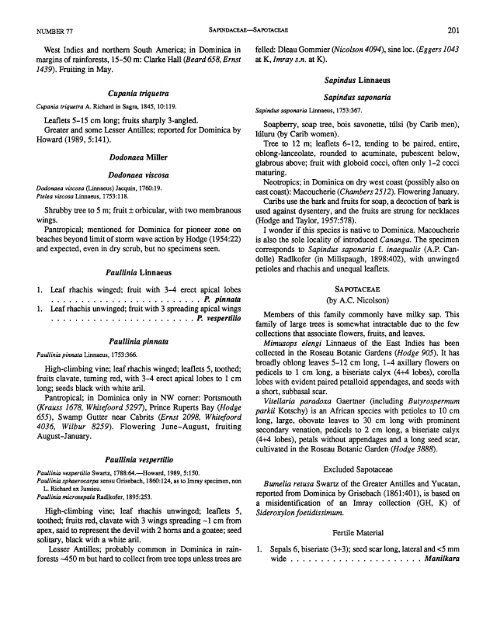Flora of Dominica, Part 2 - Smithsonian Institution Libraries
Flora of Dominica, Part 2 - Smithsonian Institution Libraries
Flora of Dominica, Part 2 - Smithsonian Institution Libraries
Create successful ePaper yourself
Turn your PDF publications into a flip-book with our unique Google optimized e-Paper software.
NUMBER 77 SAPINDACEAE~APOMCEAE 201<br />
West Indies and northern South America; in <strong>Dominica</strong> in<br />
margins <strong>of</strong> rainforests, 15-50 m: Clarke Hall (Beard 658, Ernst<br />
1439). Fruiting in May.<br />
Cupania triquetra<br />
Cupania triquetra A. Richard in Sagra, 1845, 10:119.<br />
Leaflets 5-15 cm long; fruits sharply 3-angled.<br />
Greater and some Lesser Antilles; reported for <strong>Dominica</strong> by<br />
Howard (1989,5141).<br />
Dodonaea Miller<br />
Dodonaea viscosa<br />
Dcdonaea vircosa (Linnaeus) Jacquin, 1760:19.<br />
Ptelea vircosa Linnaeus, 1753:118.<br />
Shrubby tree to 5 m; fruit k orbicular, with two membranous<br />
wings.<br />
Pantropical; mentioned for <strong>Dominica</strong> for pioneer zone on<br />
beaches beyond limit <strong>of</strong> storm wave action by Hodge (1954:22)<br />
and expected, even in dry scrub, but no specimens seen.<br />
Paullinia Linnaeus<br />
1. Leaf rhachis winged; fruit with 3-4 erect apical lobes<br />
......................... P. pinnata<br />
1. Leaf rhachis unwinged; fruit with 3 spreading apical wings<br />
........................ P. vespertilio<br />
Paullinia pinnata Linnaeus, 1753:366.<br />
Paullinia pinnata<br />
High-climbing vine; leaf rhachis winged; leaflets 5, toothed;<br />
fruits clavate, turning red, with 3-4 erect apical lobes to 1 cm<br />
long; seeds black with white aril.<br />
Pantropical; in <strong>Dominica</strong> only in NW comer: Portsmouth<br />
(Krauss 1678, Whitefoord 5299, Prince Ruperts Bay (Hodge<br />
655), Swamp Gutter near Cabrits (Ernst 2098, Whitefoord<br />
4036, Wilbur 8259). Flowering June-August, fruiting<br />
August-January.<br />
Paullinia vespertilw<br />
Paullinia vespertilio Swartz, 1788:64.-Howard, 1989,5:150.<br />
Paullinia sphoerocarpa sensu Grisebach, 1860:124, as to Imray specimen, non<br />
L. Richard ex Jussieu.<br />
Paullinia m'crosepala Radlk<strong>of</strong>er, 1895253.<br />
High-climbing vine; leaf rhachis unwinged; leaflets 5,<br />
toothed; fruits red, clavate with 3 wings spreading -1 cm from<br />
apex, said to represent the devil with 2 horns and a goatee; seed<br />
solitary, black with a white aril.<br />
Lesser Antilles; probably common in <strong>Dominica</strong> in rainforests<br />
-450 m but hard to collect from tree tops unless trees are<br />
felled Dleau Gommier (Nicolson 4094), sine loc. (Eggers 1043<br />
at K, Imray s.n. at K).<br />
Sapindus Linnaeus<br />
Sapindus saponaria<br />
Sapindus saponaria Linnaeus. 1753:367.<br />
Soapberry, soap tree, bois savonette, ttilsi (by Carib men),<br />
Mluru (by Carib women).<br />
Tree to 12 m; leaflets 6-12, tending to be paired, entire,<br />
oblong-lanceolate, rounded to acuminate, pubescent below,<br />
glabrous above; h it with globoid cocci, <strong>of</strong>ten only 1-2 cocci<br />
maturing.<br />
Neotropics; in <strong>Dominica</strong> on dry west coast (possibly also on<br />
east coast): Macoucherie (Chambers 2512). Flowering January.<br />
Caribs use the bark and fruits for soap, a decoction <strong>of</strong> bark is<br />
used against dysentery, and the fruits are strung for necklaces<br />
(Hodge and Taylor, 1957578).<br />
I wonder if this species is native to <strong>Dominica</strong>. Macoucherie<br />
is also the sole locality <strong>of</strong> introduced Cananga. The specimen<br />
corresponds to Sapindus saponaria f. inaequalis (A.P. Candolle)<br />
Radlk<strong>of</strong>er (in Millspaugh, 1898:402), with unwinged<br />
petioles and rhachis and unequal leaflets.<br />
SAF'OTACEAE<br />
(by A.C. Nicolson)<br />
Members <strong>of</strong> this family commonly have milky sap. This<br />
family <strong>of</strong> large trees is somewhat intractable due to the few<br />
collections that associate flowers, fruits, and leaves.<br />
Mimusops elengi Linnaeus <strong>of</strong> the East Indies has been<br />
collected in the Roseau Botanic Gardens (Hodge 905). It has<br />
broadly oblong leaves 5-12 cm long, 1-4 axillary flowers on<br />
pedicels to 1 cm long, a biseriate calyx (44 lobes), corolla<br />
lobes with evident paired petalloid appendages, and seeds with<br />
a short, subbasal scar.<br />
Vitellaria paradoxa Gaertner (including Butyrospermum<br />
parkii Kotschy) is an African species with petioles to 10 cm<br />
long, large, obovate leaves to 30 cm long with prominent<br />
secondary venation, pedicels to 2 cm long, a biseriate calyx<br />
(44 lobes), petals without appendages and a long seed scar,<br />
cultivated in the Roseau Botanic Garden (Hodge 3888).<br />
Excluded Sapotaceae<br />
Bumelia retusa Swartz <strong>of</strong> the Greater Antilles and Yucatan,<br />
reported from <strong>Dominica</strong> by Grisebach (1861:401), is based on<br />
a misidentification <strong>of</strong> an Imray collection (GH, K) <strong>of</strong><br />
Sideroxylon foetidissimum.<br />
Fertile Material<br />
1. Sepals 6, biseriate (3+3); seed scar long, lateral and
















